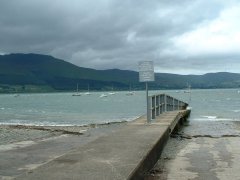Imagine standing on Warrenpoint beach looking towards Greenore. You may dip your toe in the water but from this experience alone you must deduce – without travelling on or over the sea – the nature of water, and of sea-water, of seas and oceans and currents, their total volume and extent, their composition, what plants, animals and inanimate objects are found in the sea, and the nature of the sea-bed.
This imaginary exercise offers a flavour of the problems of astronomers, cosmologists and planetary scientists. But their source is restricted to the only thing that can carry data to them across the vast distances involved – i.e. light. Amazingly, they have learned great things and this is a tribute not merely to man’s ingenuity but also to the fabulous properties of light.
I am reminded of the story of the arrogant schools science inspector interrogating the pupils. And what, Jonny, do you understand the nature of light to be? Flustered and confused, Jonny muttered that he used to know the answer but now he had forgotten. Such a pity, concluded the inspector. In all the history of the world, there were only two who ever knew – you and God – and now you have forgotten!
Common sense, or ingenuity tells you that light diminishes with distance – faintness means farness – (Remember the episode where Father Ted was holding a small plastic replica of a Friesian cow, talking to Fr Dougal and pointing out the window to the cattle in the field: You see, Dougal, he says, these are small, while those are far away!). The light from a 100W bulb at 100m might be equivalent to a 60W bulb at say, 60m. If you know the absolute magnitude of a star’s light (because, e.g. it can be identified as a certain class of star, like a Cepheid) then you can determine from that fact how far away is that star, or the galaxy in which it is located. If you are familiar with Pythagorean geometry, and can measure stellar parallax, you have a second means of determining distance – and can calibrate one with the other. There are at least eight other ways of measuring and checking distance to the stars.
The stars in their galaxies, they in clusters, and they in superclusters are the large-scale structure of the Universe. The atom with its massive nucleus of protons and neutrons surrounded by electrons is the small-scale structure. And the former is composed of the latter!
There are four fundamental forces in nature, three of them dominant at the small-scale level and the fourth, gravity, significant only at the large scale of planets, stars and galaxies. Photons – the particle of electromagnetic radiation, i.e. light – mediate between the electrons and the nucleus to prevent the atom from collapsing in on itself – and thus preventing the destruction of all matter in the Universe. This is the source and the origin of light. It is generated strongest where nuclear fusion takes place i.e. at the heart of stars. Much of this may be considered as common sense.
But you must be careful. Common sense tells us that a thing is either material or energy and that these are neither equivalent nor inter-changeable: that something is either a particle or a wave – like a water wave, a light wave or a sound wave – and not both, and that these behave differently under test conditions e.g. particles aimed at a target leave holes or indentations the shape of the particles while waves leave a contiguous wavy pattern! Common sense tells us that material things have certain absolute dimensions (a length, a breadth, a depth in a certain time) that are independent of the observer; that things are as they appear to be- and remain so even when we are not looking! And in all these examples, it is wrong.
Common sense tells us that the tree falling in the forest creates a sound even if there is no one there to hear it. Common sense tells me that my identical twin brother returning after a long space flight is still the same age as me: that if I use the same set of (very accurate) scales to weigh myself on top of the Andes, or on the floor of the grand canyon, or on the Moon, that my weight cannot vary just with location. But common sense is wrong in every one of these instances!
Einstein’s theory of relativity indicated that there are few absolutes – that space and time are different aspects of the same thing and should be referred to as spacetime: that matter and energy are likewise inter-changeable (e=mc
